Words and Photos by Michael Hultquist
Not so long ago, when seeking out spicy chile peppers at your local supermarket, you’d run across jalapeño peppers—which are wonderful in their own right—but not much more. Perhaps you’d fine some serranos, but hotter options were more difficult to find. The heat-seeking taste of the general public has evolved more recently. Habanero peppers, those bastions of heat and flavor, have gained popularity in the past several years and you’ll find them available more in more in supermarkets and chains outside of your local Mexican grocer.
This is a great thing. The discerning masses have found that chile peppers not only taste great, but bring an enjoyable heat. The public is getting hooked. As it is with many things that make you feel good, the more you get, the more you want.
Enter the “Super Hots.” These are the chile peppers that go beyond mere habanero heat. They push the boundaries of the natural Scoville Scale and make the heat you might encounter with a serrano more akin to a warm breeze on a spring day. These super hots bring spice to a whole new level.
To put things in perspective, we should discuss the Scoville Scale. The Scoville Unit of measurement was named for Wilbur Scoville in 1912. At the time, he worked for a pharmaceutical company named Parke-Davis, where he developed a test called the “Scoville Organoleptic Test,” which is used to measure chile pepper heat. In a nutshell, the higher the Scoville Unit of measurement (SHU) assigned to a chile pepper, the hotter it is.
The jalapeño pepper averages around 5,000 SHU. A serrano, which is a bit hotter than a jalapeño, measures up to 23,000 SHU. The habanero typically measures between 100,000 to 350,000 SHU. That is quite hot. But with super hot chile peppers, you get measurements like these:
- Caribbean Red Habanero: up to 475,000 SHU
- Red Savina: up to 580,000 SHU
- King Naga: up to 800,000 SHU
- Bhut Jolokia (or Ghost Pepper) – 1,000,000+ SHU
- New Mexico Scorpion: 1,191,595 SHU
- Naga Viper: 1,382,118 SHU
- Trinidad Scorpion Butch T: 1,463,700 SHU
- Trinidad Moruga Scorpion: 2,009,231 SHU
- Pepper Spray: Up to 5,300,000 SHU
Pure capsaicin, the chemical in chile peppers that makes your tongue either tingle or screech in fear (depending on the SHU), measures in at 15-16,000,000 SHU.
The fact that these super hots are SO hot shouldn’t frighten you away from cooking with them. Aside from their heat, these peppers bring an incredible flavor that you won’t get elsewhere. Many are fruity and a bit citrus-like, yet unique in their own right. Admittedly, you should begin with some milder peppers before embarking on your culinary experimentation with these chiles, but if you have a bit of a tolerance and you’re interested in cooking with them, I have a few tips that may help you.
10 Tips for Cooking with Super Hot Chile Peppers
- Practice Food Safety. The chemical that makes peppers hot—capsaicin—is an oil that will stick to your skin. It is best to wear rubber gloves when working with chile peppers if your skin is sensitive. Also, avoid rubbing your eyes or other sensitive areas of your body after handing hot peppers. It doesn’t feel good to get a blast in the eye…or anywhere else tender. Believe me, I’ve heard stories. Also, properly wash cutting surfaces after working with super hots.
- Dilution. If you’re brewing up a large pot of chili, you only need a single super hot to bring in the heat. If you’re worried, try only half a pepper and see how the heat feels. If you’ve added a super hot and just a taste of the chili burns off your taste buds, add more tomato sauce or beans to dilute the pepper heat. Consider that the 7 Pot Douglah supposedly got its name because it only took one pepper to heat 7 pots of food, so measure accordingly.
- Remove the Pepper Insides to Tame the Beast. If you deseed and scoop out the inner membrane of the peppers, you’ll have less heat. The vast majority of the capsaicin resides in this whitish membrane. You’ll still have heat, especially with these super hots. As you continue to cook with them, remove less and less of the membrane and eventually include the entire pepper to your preference.
- Keep a Dairy Product on Hand. Dairy counteracts capsaicin, so if the burning sensation overwhelms you, drink milk or dab sour cream on your tongue. It may be wise to begin with a recipe that includes some dairy. I’ve included a recipe below for homemade queso fresco with King Nagas – it is a simple cheese with a bit of a kick.
- Consider Flavors. Sure, you’re going to get extra heat with these babies, but super hots are more than just vessels of Satan’s sweat. They taste darned good! I personally enjoy the fruitiness that comes with many of these super hots, which lends itself perfectly to fruit dishes, salsas, sauces and more. Contrary to popular belief, it isn’t only about the heat in the chile pepper world. Flavor is of utmost importance to most, not counting those extreme chileheads.
- Build Up Your Tolerance. If you’re still unsure, perhaps start working with something a bit milder, like the orange habanero pepper. You will get plenty of heat and some similar flavors from orange habaneros, though the recipes won’t taste exactly the same. The more you eat spicy food, the greater your tolerance for the heat builds, as will your craving for heat (most likely). It can be a bit addictive. Believe me, I know. Once you’ve graduated past the habanero pepper, the super hots might be a great option for you.
- Split the Dish. If you’re like me, you’ll be cooking for people with different heat preferences. Some prefer their meals to be devilishly hot, while other prefer only a twinge of fire. If this is the case, when the dish is nearly done, remove the serving portions for those with a lower heat tolerance, then add the super hots into the remaining portion for yourself. This won’t work for every recipe, but it will for many.
- Enjoy the Heat! The point here is not to remove the heat of the super hot chile peppers—as if that’s even possible. The point is to experience the heat. You obviously don’t want to murder your tongue with molten lava, but if you’re experimenting with super hots, you most likely want that blast of heat. Believe me, you’ll get what you ask for. Expect it and enjoy it.
- Prepare for the Next Day. I can only relate this through an anecdote. Recently I took a road trip to Florida and stopped in Georgia for the evening. We dined at the local Wild Wing Cafe where I ordered their Braveheart Wings. These are amazingly spicy and are made with super hots. The sauce is thick and radiates heat. I muscled through 6 of them, enjoying every minute of it, but wasn’t quite prepared to drive another 700 miles in the morning after my ritual restroom visit. This doesn’t happen every time, mind you, but suffice it to say that sometimes, it’s just as hot going out as it is going in.
- Stock Up on Super Hots. You won’t find a huge selection of super hots at your local grocery store. The demand simply isn’t there yet. You can grow them yourself by ordering seeds online, or you can order the peppers themselves (or even plants) when they are in season. I have a list of places where you can purchase super hot chile peppers listed below.
Where to Purchase Super Hot Chile Peppers
- Refining Fire Chiles – http://www.refiningfirechiles.com – Purchase the Moruga Scorpion as well as any number of superhot chile peppers and more.
- Kearley Seeds & Pepper Co. –http://www.kearleyseedsandpepperco.com – Kearley Seeds & Pepper Co. offers locally grown from seed, healthy, rare pepper plants & fresh peppers.
- Bhut-Pepper.com – http://www.bhut-pepper.com – Seeds and other superhot products
- Old Barn Nursery – http://www.oldbarnnursery.com – From the owner – “Each of our plants are grown from seed at our location and raised from germination to harvest. We only sell what we have grown. We do not buy bulk seed and resell like many commercial sellers. Many of our seeds cannot be found in chain or local stores.”
- Fire Dragon Chillies – http://firedragonchillies.com – Located in New Zealand.
I’ve also cooked up a couple recipes with some King Naga peppers. I hope you enjoy them.
Queso Fresco with King Naga Chile Peppers
1-2 King Naga Chili Peppers, finely chopped
1/2 Gallon Whole Milk (Non Ultra Pasteurized)
1 tablespoon salt
1/4 cup vinegar
Heat the milk and salt in a large pot to about 190 degrees. Do not boil.
Remove from heat and stir in chili peppers.
Slowly stir in vinegar and stir continuously for about 5 minutes to allow milk to curdle.
Strain curds through a fine mesh of cheesecloth and allow to drain for about 15 minutes.
Transfer to a bowl and cover. Refrigerate for 1 hour and serve.
Editor’s note: the fat in cheese will draw capsaicin out of the chiles over time, so the queso will become even hotter as time goes by. I know this for a fact because I combined 1/4 teaspoon of super hot chile powder with 2 cups of goat chevre. It started out hot but very tolerable. By the next day, the chevre was incendiary.
Roasted Tomato Pepper Prawn Soup with King Nagas
1 pound large tomatoes
2 poblano peppers
2 jalapeño peppers
1-2 King Naga chile peppers
3-4 garlic cloves
1 large onion, chopped
1 teaspoon olive oil
20 ounces chicken stock
1/4 cup fresh basil, chopped
1-2 tablespoons Cajun seasoning
3/4 pounds large prawns, thawed if frozen
1/4 cup fresh cilantro, finely chopped
Lime zest
Queso Fresco for topping
Set your oven to broil.
Slice tomatoes and chile peppers in half lengthwise and place them on large baking sheets that have been lightly oiled.
Wrap garlic cloves in aluminum foil.
Broil the tomatoes for 10 minutes, or until they are charred and skins are loose. Remove and cool slightly.
Broil the King Nagas along with the tomatoes for 10 minutes or until until skins are charred, and remove from the oven to cool.
Broil the poblanos and jalapeños for 15-20 minutes or until the skins are charred and loosened. Remove from heat and cover with aluminum foil to slightly steam. This will help loosen the skins.
Bake the garlic in the bottom of the oven for 20 minutes. Remove from heat and peel. Chop.
Remove skins from the tomatoes and add the peeled tomatoes to a food processor. Process until smooth.
Remove the skins from the chile peppers and chop. Set aside.
Heat a large pan to medium heat and add the onion with olive oil. Cook for about 5 minutes, or until the onion softens.
Add the pureed tomatoes to the pan and stir. Add garlic, chile peppers, garlic, Cajun seasonings and stir. Cook for about 10 minutes to thicken.
Add the chicken stock and cover. Reduce heat and simmer for about 15-20 minutes to slightly reduce.
Add the prawns and cook for about 2-3 minutes, or until the prawns are cooked through.
Serve the finished soup in bowls and top with lime zest, cilantro and crumbled queso fresco.
Flat Bread Pizza with Yellow Scorpion Tomato Sauce
1-2 Yellow Scorpion chile peppers, finely chopped
2 large tomatoes, chopped
1 small onion, chopped
1 teaspoon olive oil
1/4 cup white wine
1/2 cup basil, chopped
1 teaspoon garlic, minced
Salt to taste
2 cups flour
1/4 teaspoon baking soda
4 tablespoons melted butter
pinch of salt
1/4 cup water + 1-2 tablespoons
1 cup cheese, shredded – or use queso fresco (see recipe above)
2 jalapeño peppers, roasted and chopped
Heat a saucepan to medium heat. Add the onion and olive oil and cook for about 5 minutes.
Add the white wine and simmer to reduce, about 1-2 minutes.
Add the tomatoes, chile peppers, garlic, 1/4 cup basil and salt to taste. Stir.
Cook for about 10 minutes, or until the tomatoes break down. Reduce heat to low and simmer for about 15 minutes for the flavors to develop.
Preheat oven to 350 degrees F.
In a mixing bowl, combine the flour, baking soda, salt, butter and water. Mix to form dough. Knead for about 5 minutes.
Separate the dough into 2 portions and flatten each with a rolling pin to about 1/4-inch thickness.
Heat a large grilling pan to medium-high heat and cook each flat bread dough for about 2-3 minutes, or until the dough hardens. Flip and cook another 2-3 minutes. The dough will form a cracker-like crust.
Top each pizza crust with tomato-scorpion sauce. Top with cheese, roasted jalapeños and the remaining basil.
Bake for about 10 minutes, or until the cheeses are nice and melted.
Serve!
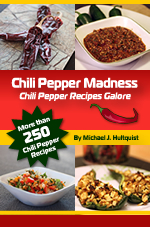
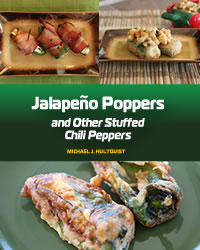 About Michael Hultquist
About Michael Hultquist
Michael Hultquist is a food writer and author of Jalapeño Madness: Jalapeño Recipes Galore! and Jalapeño Poppers and Other Stuffed Chili Pepper Recipes. You can find more recipes and chile pepper fun at his web site, www.chilipeppermadness.com.
Click on either book cover to order your copy.
Latest posts by Mark Masker (see all)
- 2024 Scovie Awards Call for Entries - 07/07/2023
- 2024 Scovie Awards Early Bird Special: 3 Days Left - 06/29/2023
- 2024 Scovie Awards Early Bird Deadline Looms - 06/25/2023

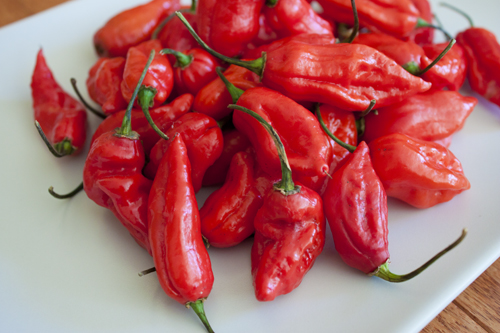






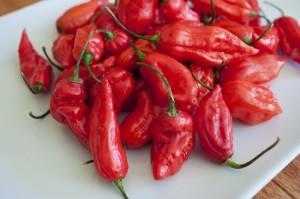

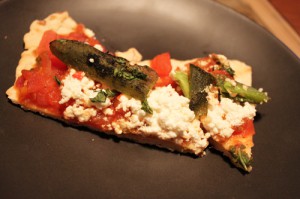
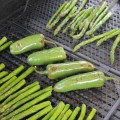

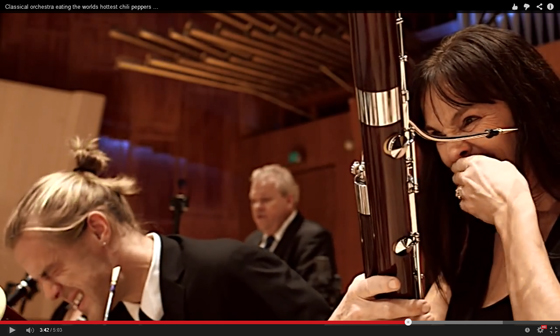
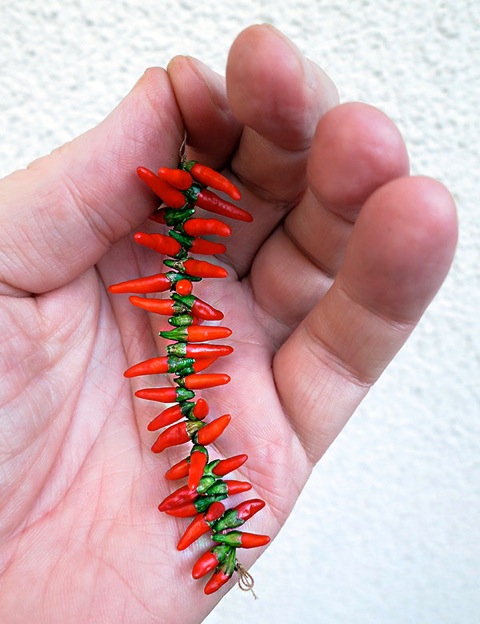
Comments
Excellent article and I’m glad to find more recipes for super hots.
My two cents about using supers are:
I’ve turned most of my superhots into jars of paste, thus allowing me to portion out amounts depending on desired heat – also allowing greater control (as opposed to putting in chiles into your dish and running the risk of nuking the food).
Another trick I’m partial to is adding supers to chile blends (paste or powder) I currently have on hand. Some bhut jolokia powder added to chipotle not only jacks up the heat but puts a spin on that same old same old chiptole flavour.
Good cooking and best wishes!
Pingback: Holy Jalapeño! A Poppers Cookbook |
Pingback: My Return to the Pepper Plant Mecca: Cross Country Nurseries « PEPPERMEISTER!
Pingback: PEPPERMEISTER’S Official 2012 Grow List « PEPPERMEISTER!
I’m so glad I found your blog.
I love fire foods.
Do you have any links in here (I would look, but I’m feeling a little lazy at the moment) on home made hot sauce?
Hey Banana,
You can find great recipes for home made hot sauce on the Fiery Foods & BBQ SuperSite by doing a search for hot sauce in the recipe database. But if you’re feeling REALLY lazy, just go to the article on http://www.fiery-foods.com about making hot sauce.